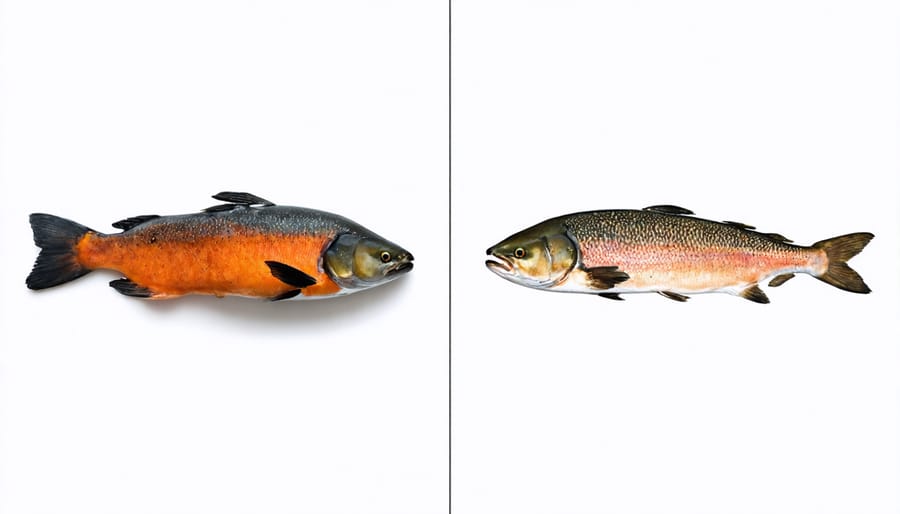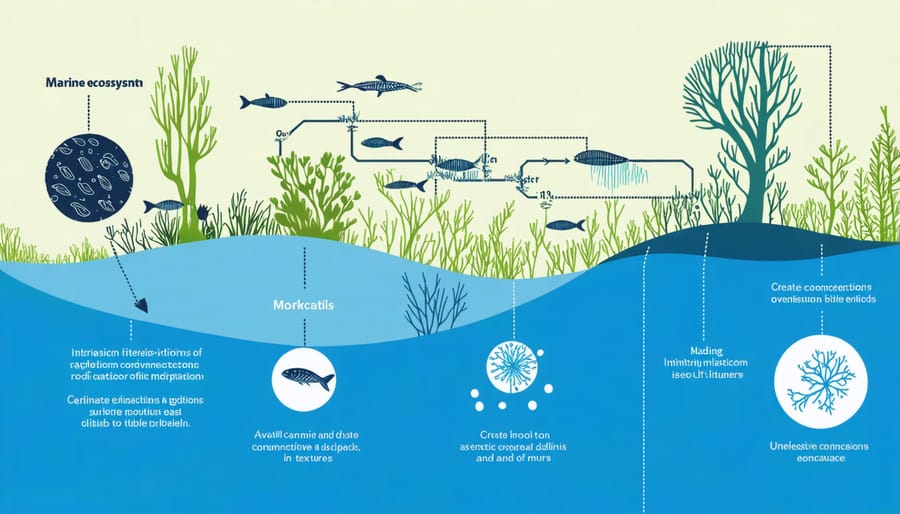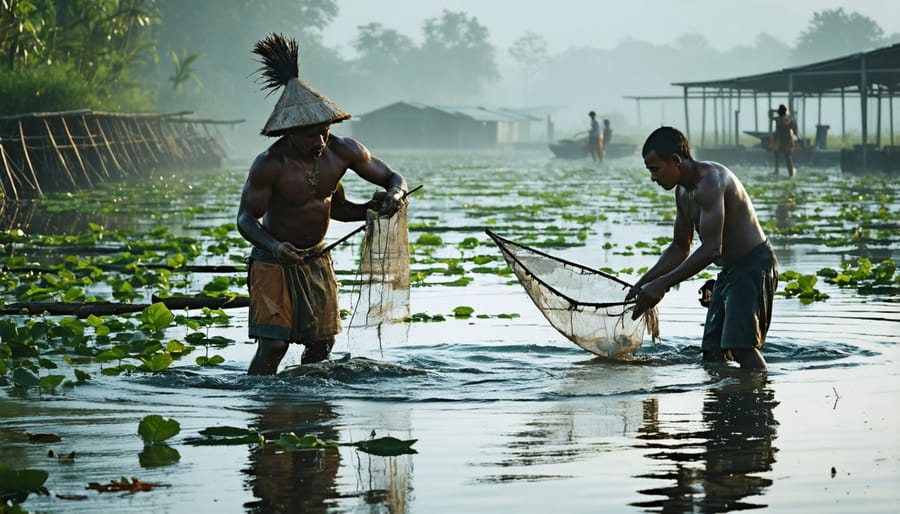
The revolutionary potential of marine genetic engineering principles brings us to a critical crossroads in human history. As we develop the capability to rewrite the genetic code of life itself, we face profound ethical questions that extend far beyond laboratory walls and into the very fabric of our society and natural world.
From enhancing crop resilience to eliminating hereditary diseases, genetic engineering offers unprecedented opportunities to reshape our future. Yet these remarkable possibilities come with weighty responsibilities and complex moral considerations. Scientists, ethicists, and policymakers grapple with fundamental questions: What are the boundaries of human intervention in nature? How do we ensure equitable access to genetic technologies while preventing their misuse? What unforeseen consequences might emerge from our genetic modifications?
The stakes are particularly high in marine environments, where genetic alterations could ripple through entire ecosystems. As we stand at this technological frontier, we must carefully balance scientific progress with environmental stewardship, human welfare with ecological preservation, and innovation with responsibility.
This article explores the intricate ethical landscape of genetic engineering, examining its potential benefits and risks, while considering the crucial frameworks needed to ensure its responsible development. Through understanding these complex dynamics, we can work toward harnessing this powerful technology for the benefit of both humanity and our planet’s diverse ecosystems.
Current Applications of Marine Genetic Engineering
Aquaculture Enhancement
Genetic modifications in aquaculture have emerged as a powerful tool for enhancing fish production and addressing global food security challenges. Through advanced gene-editing techniques, scientists can now develop fish species with improved growth rates, disease resistance, and environmental adaptability. For instance, AquAdvantage salmon, the first genetically modified fish approved for human consumption, grows twice as fast as conventional salmon while consuming less feed.
However, these developments raise significant ethical considerations. The potential escape of genetically modified organisms into natural ecosystems could threaten wild populations through competition and genetic contamination. To address these concerns, many facilities have implemented sustainable aquaculture methods that include multiple containment barriers and sterile fish populations.
Marine biologists like Dr. Sarah Chen, who has spent two decades studying fish genetics, emphasize the importance of balanced approaches. “While genetic engineering offers promising solutions for food security,” she notes, “we must prioritize biodiversity conservation and ecosystem health.” This involves careful risk assessment, robust containment protocols, and ongoing monitoring of potential environmental impacts. The future of aquaculture enhancement lies in finding the delicate balance between innovation and environmental stewardship.

Conservation Applications
Genetic engineering offers promising solutions for protecting endangered marine species, though its application requires careful consideration and ethical oversight. Marine biologists are exploring how genetic techniques could bolster declining populations of coral reefs by enhancing their resilience to warming waters and ocean acidification. Through selective breeding and genetic modification, scientists can potentially strengthen species’ resistance to disease and environmental stressors.
In the case of critically endangered species like the vaquita porpoise, genetic engineering could help maintain genetic diversity in small populations, reducing the risk of inbreeding depression. Similarly, researchers are investigating ways to protect sea turtles by potentially modifying their genes to better cope with rising temperatures, which affect offspring gender ratios.
However, these interventions must be approached with caution. Scientists must consider the broader ecosystem impacts and potential unintended consequences. Success stories, like the genetic rescue of the black-footed ferret, provide valuable insights for marine conservation efforts. The key lies in balancing technological innovation with ecological preservation, ensuring that genetic interventions support rather than replace traditional conservation measures like habitat protection and pollution reduction.
Key Ethical Concerns
Ecosystem Impact
Genetic engineering in marine environments poses significant challenges to ocean ecosystem balance and biodiversity conservation. When modified organisms are introduced into marine ecosystems, they can interact with native species in unpredictable ways, potentially leading to competition for resources, altered food chains, or unexpected genetic transfer through cross-breeding.
Marine biologist Dr. Sarah Chen notes, “Even small changes to a single species’ genetic makeup can trigger ripple effects throughout the entire ecosystem. We’ve observed modified salmon, for instance, displaying increased aggression and consuming more resources than their wild counterparts.”
The release of genetically engineered organisms into marine environments raises particular concerns due to the interconnected nature of ocean ecosystems. Unlike controlled terrestrial environments, ocean currents can transport modified organisms far beyond their intended boundaries, potentially affecting numerous ecosystems and species populations across vast geographic areas.
Key risks include:
– Displacement of native species
– Disruption of natural breeding patterns
– Unintended gene transfer to wild populations
– Changes in predator-prey relationships
– Alterations to local food web dynamics
Conservation efforts must carefully weigh the potential benefits of genetic engineering against these ecological risks. While some modifications might aim to enhance species resilience or restore threatened populations, the long-term consequences for marine biodiversity require thorough assessment and ongoing monitoring to prevent irreversible ecosystem damage.

Ownership and Access Rights
The question of who owns genetic resources and has the right to modify them remains one of the most contentious issues in genetic engineering. As marine scientists discover new genetic sequences with potential applications in medicine, agriculture, and conservation, the debate over ownership and access rights intensifies.
Traditional knowledge holders, particularly indigenous communities who have long understood local marine ecosystems, often find themselves excluded from benefits when their knowledge leads to genetic discoveries. Meanwhile, large biotechnology companies secure patents on genetic sequences, raising concerns about monopolization of genetic resources that arguably belong to all humanity.
The Nagoya Protocol, established in 2010, attempts to address these issues by ensuring fair benefit-sharing and requiring prior informed consent for accessing genetic resources. However, implementation remains challenging, especially in marine environments where resources often cross national boundaries.
Scientists advocate for an open-source approach to genetic information, similar to the collaborative spirit that drove the Human Genome Project. This would ensure broader access to genetic resources while still protecting intellectual property rights for specific applications.
The rise of bioprospecting in marine environments has highlighted the need for clearer international frameworks. Some nations have established genetic resource banks, ensuring local communities benefit from discoveries while promoting conservation efforts. These models demonstrate how ethical access and fair benefit-sharing can support both scientific advancement and community rights.
Indigenous Rights and Traditional Knowledge
Indigenous communities worldwide have maintained deep connections with marine ecosystems for millennia, developing sophisticated traditional knowledge systems about marine species and their habitats. As genetic engineering technologies advance, these communities raise important concerns about the potential impact on their cultural heritage and traditional resource management practices.
Many indigenous groups view marine organisms not just as resources, but as integral parts of their cultural identity and spiritual beliefs. The genetic modification of marine species can conflict with traditional beliefs about the sanctity of natural life forms and ancestral relationships with the ocean. For instance, Pacific Island communities have expressed concerns about the genetic modification of fish species that play central roles in their cultural practices and traditional fishing methods.
Traditional ecological knowledge, passed down through generations, often provides valuable insights into sustainable marine resource management. This knowledge includes understanding complex ecological relationships, seasonal patterns, and sustainable harvesting practices. Scientists and conservation organizations increasingly recognize the importance of incorporating this traditional wisdom into modern conservation efforts and genetic engineering discussions.
Several indigenous communities have called for stronger protections of their rights in genetic engineering decisions, particularly regarding the patenting of marine genetic resources from their traditional waters. They advocate for principles of free, prior, and informed consent, ensuring their voices are heard in decisions that could affect their traditional marine resources and way of life.

Regulatory Framework
The regulation of genetic engineering in marine environments operates within a complex framework of international agreements and national policies. The Convention on Biological Diversity (CBD) serves as the primary international framework, establishing guidelines for the responsible use of genetic technologies while protecting marine ecosystems. Under these marine resource regulations, nations must implement strict protocols for research and commercial applications of genetic engineering in marine species.
Key regulatory bodies include the International Maritime Organization (IMO) and regional fisheries management organizations, which oversee the implementation of safety measures and environmental impact assessments. The Cartagena Protocol on Biosafety, specifically addressing the handling and transfer of genetically modified organisms, requires detailed risk assessments before any genetic engineering projects can proceed in marine environments.
Scientists and research institutions must obtain multiple permits and undergo rigorous review processes before conducting genetic engineering experiments on marine organisms. These requirements typically include:
– Detailed documentation of containment measures
– Environmental impact studies
– Risk assessment protocols
– Regular monitoring and reporting
– Emergency response plans
National regulatory frameworks vary significantly, with some countries adopting more stringent approaches than others. For example, Norway and New Zealand have implemented comprehensive regulations specifically addressing genetic modifications in aquaculture, while other nations are still developing their regulatory frameworks.
The challenge lies in balancing scientific advancement with environmental protection. As genetic engineering technologies evolve, regulatory bodies must continuously update their guidelines to address new capabilities and potential risks. This adaptive approach ensures that innovation can proceed while maintaining robust safeguards for marine ecosystems and biodiversity.
Sustainable Solutions
Best Practices
To ensure responsible genetic engineering in marine environments, scientists and researchers must adhere to strict protocols and ethical guidelines. First and foremost, extensive risk assessments should be conducted before any genetic modifications are implemented, including thorough evaluation of potential impacts on marine ecosystems and biodiversity.
Researchers should prioritize containment measures to prevent modified organisms from escaping into natural environments. This includes using physical barriers, biological containment methods, and implementing multiple redundant safety systems. Regular monitoring programs must be established to track any potential changes in local ecosystems where genetic engineering research is conducted.
Transparency is crucial – all research data, methodologies, and findings should be openly shared with the scientific community and relevant stakeholders. This enables peer review and helps build public trust. Additionally, engagement with local communities, particularly those dependent on marine resources, should be prioritized during planning and implementation phases.
Scientists should also maintain detailed documentation of all genetic modifications and their potential effects. A precautionary approach is essential, with clear exit strategies in place if unexpected consequences arise. Regular ethical reviews by independent committees help ensure compliance with established guidelines and maintain high standards of responsibility in marine genetic engineering projects.
Future Directions
As genetic engineering technology continues to evolve, several promising developments are emerging to address current ethical concerns. CRISPR-based genetic editing is becoming more precise, reducing the risk of unintended mutations and off-target effects. Scientists are developing reversible gene modifications that can be undone if unexpected consequences arise, providing a safety net for genetic interventions.
New containment strategies are being designed to prevent genetically modified organisms from interacting with wild populations. These include molecular constraints that limit an organism’s ability to reproduce outside controlled environments and geographic isolation protocols for testing modified species.
Artificial chromosomes and synthetic biology approaches offer ways to add beneficial traits without altering existing genes, potentially reducing ethical concerns about preserving natural genetic heritage. Additionally, improved computational modeling helps predict the environmental impact of genetic modifications before implementation.
Public engagement initiatives are expanding, with scientists actively involving communities in discussions about genetic engineering applications. This collaborative approach helps ensure that future developments align with societal values and address real-world needs while maintaining ethical standards.
As our understanding of genetics deepens, we can expect more sophisticated solutions that balance scientific progress with ethical considerations, potentially revolutionizing fields from medicine to conservation while respecting biological and ethical boundaries.
As we navigate the complex landscape of marine genetic engineering, it’s crucial to recognize both its transformative potential and inherent responsibilities. Throughout this exploration, we’ve seen how genetic engineering offers promising solutions for marine conservation, from enhancing coral reef resilience to protecting endangered species. However, these advances come with significant ethical considerations that demand our careful attention.
The key to moving forward lies in striking a delicate balance between scientific progress and environmental stewardship. We must prioritize transparent research practices, robust safety protocols, and inclusive dialogue among scientists, conservationists, and local communities. The establishment of comprehensive regulatory frameworks, coupled with ongoing ecological impact assessments, will help ensure that genetic engineering serves as a tool for conservation rather than exploitation.
As marine scientists and concerned citizens, we all have a role to play in shaping the future of genetic engineering in our oceans. This includes supporting research institutions that maintain high ethical standards, participating in public discussions about genetic engineering policies, and staying informed about new developments in the field.
Looking ahead, we must commit to responsible innovation that respects marine ecosystems’ integrity while addressing urgent conservation challenges. By fostering collaboration between researchers, policymakers, and conservation groups, we can harness genetic engineering’s potential while safeguarding our oceans for future generations.
jessica
Ava Singh is an environmental writer and marine sustainability advocate with a deep commitment to protecting the world's oceans and coastal communities. With a background in environmental policy and a passion for storytelling, Ava brings complex topics to life through clear, engaging content that educates and empowers readers. At the Marine Biodiversity & Sustainability Learning Center, Ava focuses on sharing impactful stories about community engagement, policy innovations, and conservation strategies. Her writing bridges the gap between science and the public, encouraging people to take part in preserving marine biodiversity. When she’s not writing, Ava collaborates with local initiatives to promote eco-conscious living and sustainable development, ensuring her work makes a difference both on the page and in the real world.
